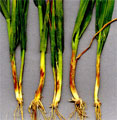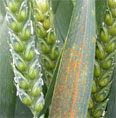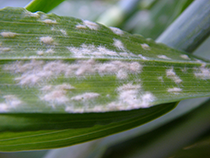| Resistance genes | Varieties with good resistance are known, and help to reduce disease levels. Many specific genes are used and described but also non-specific resistance genes are known to be of importance. [30] |
|
| Previous crop | If volunteers have been removed the impact is small. |
|
| Sowing date | Early sowing is known to increase disease level in autumn, but this rarely have impact on disease levels in spring. Late sowing in the autumn has been seen to increase disease level in spring, as the very young plants in spring generally are more susceptible than early sown crops. [14] |
|
| Tillage | Ploughing has been found to increase the risk of mildew compared with minimal tillage. It is the increased mineralization of nitrogen following ploughing, which stimulates a more severe attack. [27] |
|
| Debris and volunteers | Debris does not directly influence disease levels as mildew is an obligate parasite. Fields with volunteers are an important source of inoculum as it serves as a green bridge for the spread of the disease between seasons. |
|
| Nitrogen level | High nitrogen use increases the susceptibility of the crop due to higher N concentration in leaves, easier penetration of the fungus. Possibly also due to denser crop with higher levels of humidity, which stimulates the epidemic. [34,35] |
|
| Nitrogen strategy | Spilt strategies of N are less likely to encourage high disease levels compared to single applications of a single high level. [34,35] |
|
| Crop density | High crop density stimulates mildew development as the humidity in the crop favours disease development. Overlapping in headlands often has higher levels of attack. [28] |
|
| Landscape | The attacks are known to be more severe near hedges and in low and humid parts (black soils) of the field. [4] |
|
| Soil type | Sandy soils are known to stimulate the disease development. This is often related to manganese deficiency which makes the crop more prone to mildew, It might also be related to the crop being more exposed to stress on these soils or higher levels of leaf wetness due to higher differences between plant and soil temperatures. Stress in the form of drought can also increase the risk of mildew. [14] |
|
| Weather | As temperatures rise in the spring, dormant mycelium starts to grow and spores are quickly produced. The disease is not very temperature dependant although 15 C is optimal with relative humidity above 95%. Free water inhibits spore germination. Under dry conditions spores can be formed in about seven days. |
|
Powdery mildew is generally most important at early growth stages in spring. Risk is often linked to specific regions and soils where the farmers from experience need to be very alert. The risk is often considered to be high on late sown crops, near hedges and on sandy soil. Look out for the disease on all green parts between GS 29 and 55. The control threshold early in the season is low in susceptible cultivars. Effective control using specific mildewicides requires treatments at low disease levels. Autumn attack may be found but is not considered to have economic importance. Control is not regarded to be economical after heading. Keep a check on national ranking of the cultivars susceptibility in order to be aware if you have a high or low risk situation. Mildew is so visible that the likely amount of damage may be overestimated. Low levels of attack as often seen around heading on the lower part of the crop are regarded not to have economic importance. |







